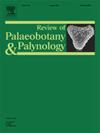A marattialean fern with in situ spores, Cyathocarpus benefoliatii sp. nov., from the Lopingian of Southwest China
IF 1.7
3区 地球科学
Q2 PALEONTOLOGY
引用次数: 0
Abstract
A species of adpressed marattialean fern having pinnules with fertile organs, Cyathocarpus benefoliatii Yu.Guo, Zhou et Z.Feng sp. nov., is established from the Lopingian (upper Permian) of eastern Yunnan Province, Southwest China. Fronds of this new species are at least tripinnate, with alternately arranged penultimate pinnae, alternately or suboppositely arranged ultimate pinnae, and alternately arranged pinnules. Fertile pinnules are linguiform in shape and abaxially bear a row of 4–7 synangia tightly arranged on each side of the midvein from the base to the apex. Synangia are ovoidal, radially symmetrical, and individually consists of 4 or 5 exannulate sporangia. Sporangia are ovoidal and laterally fused along most or all of their length. The inner-facing sporangial wall has one layer of cells, while the outer-facing sporangial wall has three layers of cells. In situ spores of the Laevigatosporites/Latosporites type are 43–61 μm in diameter, monolete, and laevigate. The exine encompasses a perine, a sexine, and a nexine. These characteristics indicate that Cyathocarpus benefoliatii sp. nov. belongs to the Pecopteris trevirani Group (palynological grouping) of Paleozoic marattialeans.
中国西南罗平滇地区发现的一种具有原位孢子的蕨类植物--Cyathocarpus benefoliatii sp.
从中国西南部云南省东部的罗平系(上二叠统)中发现了一种具有羽片和能育器官的褶皱蕨类植物--Cyathocarpus benefoliatii Yu.Guo, Zhou et Z.Feng sp.nov.。该新种的叶片至少呈三出羽状,具有交替排列的倒数第二羽片、交替或近倒数排列的末级羽片以及交替排列的小羽片。能育小羽片呈舌状,背面有一排 4-7 个合蕊器,紧密排列在中脉两侧,从基部到先端。合生孢子卵球形,辐射对称,单个由 4 或 5 个无柄孢子囊组成。孢子囊呈卵圆形,沿其大部分或全部长度侧面愈合。面向内侧的孢子囊壁有一层细胞,面向外侧的孢子囊壁有三层细胞。Laevigatosporites/Latosporites 型的原位孢子直径为 43-61 μm,单孢子囊,呈扁平状。外膜包括包膜、性膜和轴膜。这些特征表明,Cyathocarpus benefoliatii sp.
本文章由计算机程序翻译,如有差异,请以英文原文为准。
求助全文
约1分钟内获得全文
求助全文
来源期刊
CiteScore
3.50
自引率
21.10%
发文量
149
审稿时长
6 months
期刊介绍:
The Review of Palaeobotany and Palynology is an international journal for articles in all fields of palaeobotany and palynology dealing with all groups, ranging from marine palynomorphs to higher land plants. Original contributions and comprehensive review papers should appeal to an international audience. Typical topics include but are not restricted to systematics, evolution, palaeobiology, palaeoecology, biostratigraphy, biochronology, palaeoclimatology, paleogeography, taphonomy, palaeoenvironmental reconstructions, vegetation history, and practical applications of palaeobotany and palynology, e.g. in coal and petroleum geology and archaeology. The journal especially encourages the publication of articles in which palaeobotany and palynology are applied for solving fundamental geological and biological problems as well as innovative and interdisciplinary approaches.

 求助内容:
求助内容: 应助结果提醒方式:
应助结果提醒方式:


